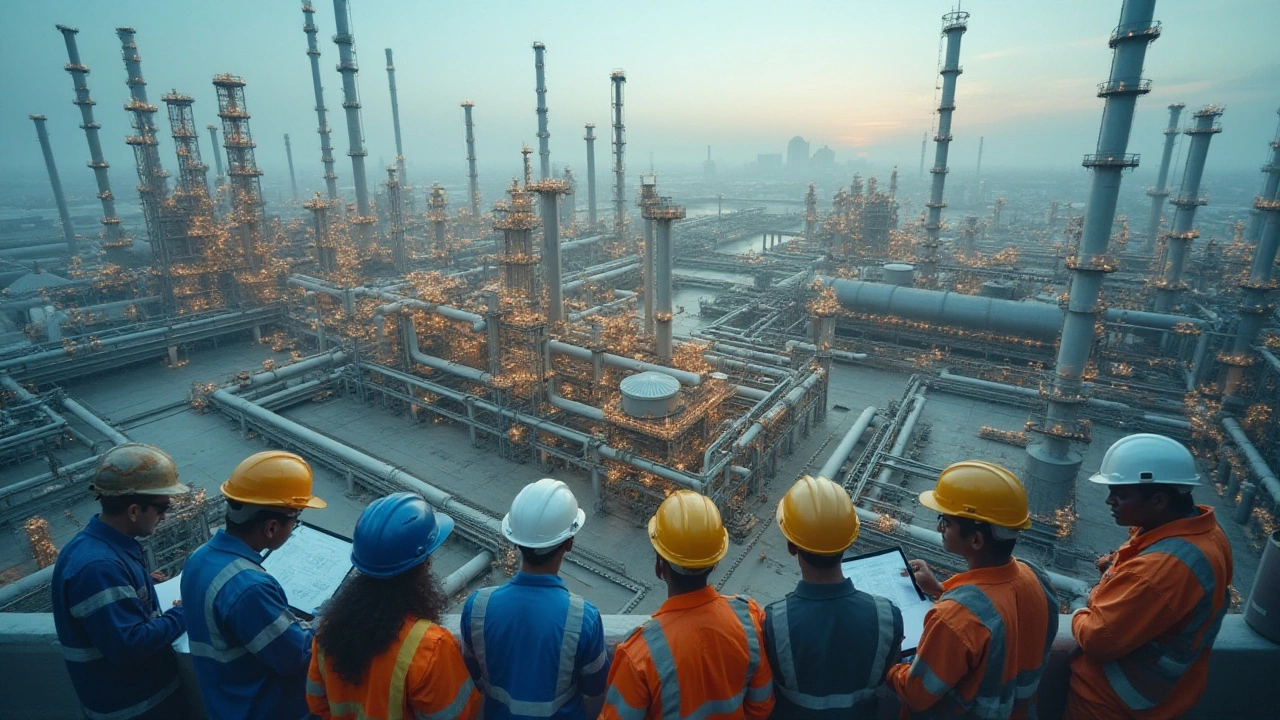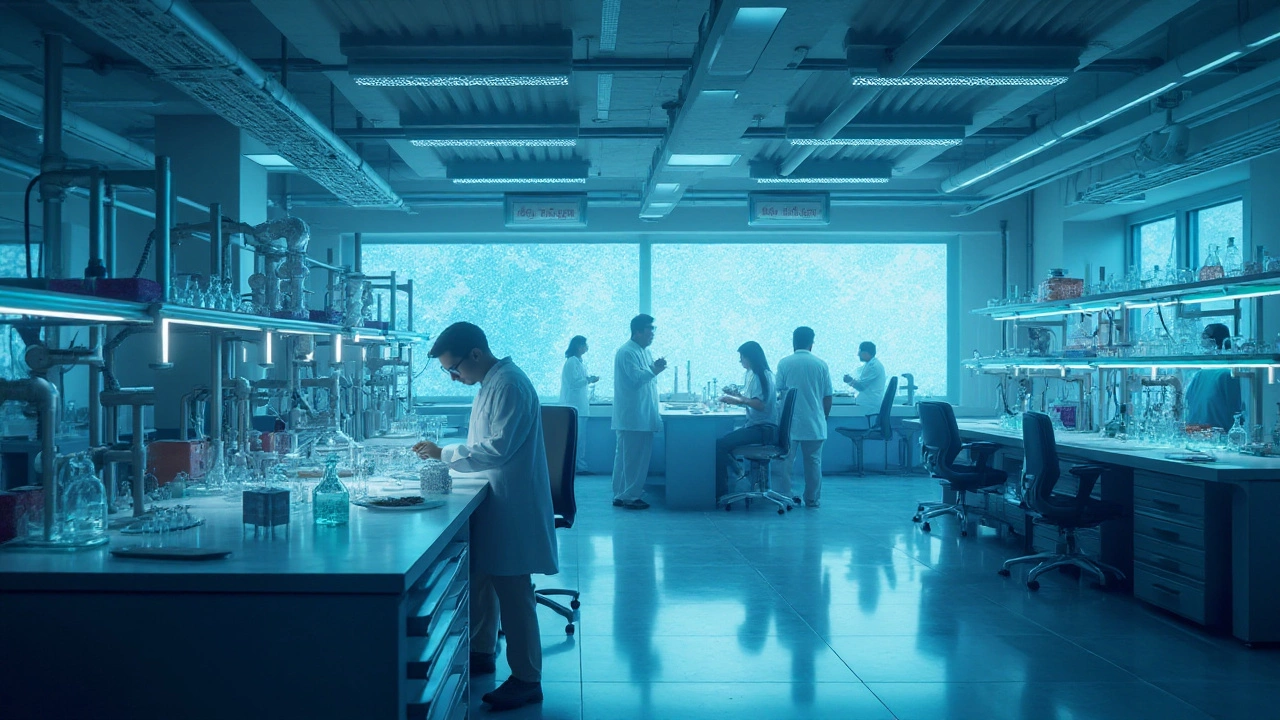 Jan, 2 2025
Jan, 2 2025
Diving into the world of chemical manufacturing, the question remains: which nation currently dominates this industrial powerhouse? As we step into 2025, the landscape of the chemical industry has never been more competitive or more vital to global economies. Companion industries like agriculture, pharmaceuticals, and construction rely heavily on the chemical sector's innovations and efficiencies.
Amongst a field of strong contenders, one country has carved out a preeminent position for itself, thanks to a blend of groundbreaking advances, formidable manufacturing capacity, and strategic global trading practices. With significant investments in research and development, this leading nation constantly pushes the boundaries, setting new benchmarks for others to follow.
Meanwhile, countries like India are trailing closely and showing unprecedented growth, leaning heavily into their considerable pool of skilled labor and burgeoning domestic market to fuel progress. Unlike what some might expect, India's chemical industry has been breaking records, becoming a pivotal player on the global stage.
Join us as we delve deeper into the manufacturing giants steering the chemical industry today, uncover the secrets of their success, and anticipate the trends and challenges that lie ahead in this ever-evolving landscape.
- Current Global Leader in Chemical Production
- Factors Contributing to Leadership
- India's Role and Growth in the Chemical Sector
- Future Trends and Challenges
Current Global Leader in Chemical Production
As of 2025, one country stands at the pinnacle of the chemical industry, setting the pace and redefining standards on a global scale. This leader is none other than Germany. Known for its engineering prowess and innovative spirit, Germany has been the industrial powerhouse of Europe for decades. Its rise in the chemical sector is no less impressive. Home to giants like BASF, the world's largest chemical producer, Germany's contributions to chemical advancements cannot be overstated. A combination of cutting-edge research, a solid infrastructure, and skilled workforce positions Germany as a key player in this fiercely competitive arena.
Germany's strategic location in the heart of Europe provides a unique advantage, making it a nexus for transporting goods to and from other European nations. It benefits from a stable regulatory environment that encourages investment in advanced technologies and sustainability practices. Companies within Germany are at the forefront of creating eco-friendly alternatives that lessen the environmental impact of traditional chemical processes. This dedication to green chemistry not only places Germany in a leadership position economically but also ethically, prompting others to follow its lead.
In 2023, Germany's chemical industry reported an annual turnover in the hundreds of billions of euros, further cementing its top position. The importance of the industry to the country's economy cannot be understated, as it employs hundreds of thousands of workers and represents a significant portion of Germany's exports. As Angela Merkel famously stated,
"The future belongs to those who innovate, and Germany's chemical industry is a testament to this truth."This sentiment runs deep within the country's economic philosophy, driving them continuously forward.
An analysis of Germany’s success can't overlook its relentless pursuit of collaboration between academia and industry. University research labs and corporate R&D departments work hand-in-hand to drive discovery and innovation. This cross-pollination fosters a hub of creativity and technology that births many breakthrough innovations in chemical production. Germany’s research on hydrogen as an alternative fuel source is a prime example of this synergy, where collective efforts have positioned the nation as a global leader in the transition towards sustainable energy forms.
To sustain its leadership, Germany faces constant pressure to adapt to global trends, such as digital transformation and sustainability mandates. An interesting point to note is the role of the European Green Deal, which pushes companies toward circular economies and reduced carbon footprints. As a leader, Germany often finds itself as the trendsetter, navigating these transformations successfully and setting standards others strive to achieve. Facing such challenges head-on while remaining at the cutting edge of technology illustrates why Germany is seen as a trailblazer in the ever-evolving landscape of the chemical industry.
| Year | Turnover (in billion euros) |
|---|---|
| 2021 | 190 |
| 2022 | 200 |
| 2023 | 210 |

Factors Contributing to Leadership
In the competitive arena of the chemical industry 2025, several key factors are essential for any country aspiring to lead. Central to this achievement is a robust infrastructure that supports large-scale manufacturing processes while ensuring environmental sustainability. This combination allows for efficient production while maintaining a commitment to reducing emissions and waste. Equally important is access to abundant and diverse resources—both natural and human. Countries that possess rich deposits of essential raw materials can minimize supply chain disruptions, keeping production costs manageable.
Another critical component is the degree of investment in research and development. Leading nations pour billions into R&D, fostering innovation that enables the production of advanced chemicals with higher value. In recent years, technologies such as artificial intelligence and machine learning have been integrated into chemical processes, driving efficiency and creating new product lines. Properly leveraging these disruptive technologies gives companies a competitive edge and opens up vast opportunities for growth.
Trade policies and international relations also play a significant role. Nations that cultivate strong, reciprocal trade agreements ensure seamless access to international markets, ultimately expanding their consumer base and reducing trade barriers. Strategic geopolitical positioning can be as vital as any physical resource, allowing chemical products to flow freely across borders.
"Innovative technology is reshaping the chemical landscape in ways we could not have anticipated even five years ago," remarked Dr. Anika Schultz, a renowned chemical industry analyst.
Workforce proficiency cannot be overlooked. The availability of a highly skilled labor force, particularly in technology and engineering disciplines, is pivotal. Countries with strong educational frameworks in these areas can sustain and drive continual innovations, enriching their economic fabric. Additionally, government support in the form of subsidies and favorable regulations creates an environment conducive to industrial growth.
Let's not forget the impact of consumer trends and demand dynamics. Countries that can rapidly adapt to changing consumer preferences, such as the increasing demand for eco-friendly and non-toxic chemicals, are likely to maintain leadership. By investing in alternative and renewable chemical sources, these nations ensure long-term viability and relevance in an ever-evolving market.
Finally, public-private collaboration often spearheaded by think tanks and consortiums, can drive competitive advantages. Such partnerships blend resources and expertise from diverse sectors, which can accelerate advancements and enhance industry standards. In essence, the intricate interplay of these factors crafts a scaffold on which global chemical industry leaders can build enduring success.

India's Role and Growth in the Chemical Sector
The dynamic and evolving nature of the global chemical industry has witnessed several regional shifts, but perhaps none as promising as India's rapid ascent. With an already formidable presence in the industrial world, India continues to redefine what's possible in chemical manufacturing. Sketched against a backdrop of expansive growth, India's chemical sector is fueled by a potent combination of a vast pool of skilled professionals, state-driven policies, and a robust domestic market. All these factors are knitting together to manifest a scene of opportunity echoing the ethos of an industry that's as vibrant as it is varied.
A major catalyst for this growth is the Indian government's proactive approach. Initiatives aimed at nurturing industrial infrastructure and economic zones tailored for chemical manufacturers have built an ecosystem where innovation thrives. The 'Make in India' initiative serves as a notable flagship program, designed to attract investors by creating a conducive environment for manufacturing and development. It aligns perfectly with the country's economic goals, emphasizing home-grown manufacturing excellence.
Simultaneously, the global marketplace is responding to India's rise with interest and initiative. Trade agreements focusing on chemical and allied sector products are being inked, potentially increasing India's export basket significantly. This favorable trade landscape provides India not merely with access to new markets but also with avenues to import cutting-edge technologies advancing its chemical manufacturing capabilities.
The prowess of India's chemical sector is further underlined by its expansive contribution to the overall GDP. Reports from 2023 indicated that this sector generated a revenue of around USD 300 billion, marking a consistent year-on-year increase and forecasted to reach USD 400 billion by 2025. Such impressive numbers may stem from the diverse sub-sectors within the industry, ranging from petrochemicals to specialty chemicals and fertilizers.
In the sphere of specialty chemicals, India holds a distinct advantage. The demand from domestic textile, construction, and pharmaceuticals industries has spurred local companies to innovate and compete on a global scale. Companies such as Reliance Industries and Tata Chemicals are carving niches, routinely featuring in lists of the world's top chemical enterprises.
The future of India's chemical sector lies not just in innovation and manufacturing but in its ability to meld sustainable practices with profitability — a belief echoed succinctly by industry stalwart Mukesh Ambani, who recently noted, "We must focus on sustainable chemical processes that align with global environmental norms."
Lastly, given its young demographic, India's potential workforce is gaining attention. Training programs, sometimes in collaboration with leading universities and global chemical giants, are equipping a new generation with the necessary skills to sustain this roaring growth. As the nation continues its trajectory of becoming a global leader, all eyes are on how it integrates these strengths into future advancements, addressing challenges such as climate change and resource scarcity along the way.

Future Trends and Challenges
The chemical industry is at the cusp of revolutionary changes, and the coming years are promising to bring monumental shifts in how we approach manufacturing and sustainability. In 2025, the focus on eco-friendly products has never been more paramount, and as concerns over global warming escalate, industries worldwide are being pushed to reconsider their production techniques. The chemical sector is no exception, and companies are investing heavily in green chemistry principles, striving to minimize waste, reduce emissions, and create products that are both effective and kind to the environment.
Technological advancements are leading the charge with developments such as artificial intelligence and machine learning, which are optimizing processes and predicting trends in a way that was unimaginable a decade ago. These technologies not only improve efficiency but also help in enhancing safety measures across manufacturing plants. An industry's ability to leverage data analytics for its operations promises a significant competitive edge. For instance, predictive maintenance using AI can foresee potential machinery breakdowns, substantially reducing downtimes.
The industry is witnessing a shift in supply chain dynamics, focusing more on localization due to the aftermath of global disruptions like the COVID-19 pandemic. This movement towards sourcing raw materials locally not only helps in reducing dependency on international trade routes but also supports the local economy and reduces carbon footprints. However, with this shift, the challenge lies in maintaining the quality and consistency of raw materials at a competitive price.
Moreover, as urbanization escalates, the demand for specialty chemicals required for infrastructure and extended city planning will surge. The chemical industry will need to cater to the increasing needs of urban construction, water treatment, and sustainable energy solutions. India's aspirations of emerging as a global chemical manufacturing hub align with these growth trajectories. Speaking at an industry conference, a renowned industry leader quipped, "The future belongs to those who see possibilities before they become obvious."
Another challenge the sector faces is the volatility of raw material prices and the geopolitical tensions that can lead to supply chain disruptions. Such uncertainties necessitate robust risk management strategies and a flexible approach to sourcing and logistics. With regulatory environments becoming stricter, companies must ensure compliance while continuing to innovate. This balancing act between adhering to new regulations and driving innovation presents a significant obstacle but also an opportunity for growth and improvement.
In response to these challenges, some chemical manufacturers are exploring the use of biotechnology and synthetics as alternatives to traditional raw materials. By doing so, they not only diversify their input sources but also reduce reliance on finite resources. This forward-thinking approach is indicative of the broader trend in the industry: adaptability and innovation. Capturing opportunities in these emerging trends will be crucial for any nation seeking to maintain or gain a foothold as a leader in the chemical industry by 2025 and beyond.